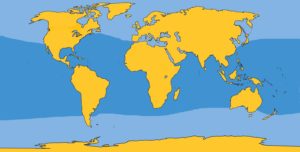 Family: Balaenopteridae
Family: Balaenopteridae
Genus: Balaenoptera
Species: B. edeni Lesson, 1828
Taxonomic Note: Some researchers recognize a similar animal for which they have given a separate species identification as Omura’s whale (Balaenoptera omura). Confirmation of this is speculative and if globally recognized, a separate species page will be added.
Bryde’s whales (often pronounced “brudas”) inhabit the tropical and subtropical oceans of the world and are naturally not as numerous as other rorqual species because food is less abundant in tropical waters. They are often confused with sei whales, but can be distinguished by the three prominent ridges present on their head. If close-up inspection is possible, the coarse gray baleen and ventral throat pleats extending to or beyond the navel are additional characteristics that identify Bryde’s whales. These whales are rather solitary in their habits, usually keeping their distance from each other even when there is a local abundance of food.
Oceanographers from the Galapagos Islands report a Bryde’s whale encounter in 1979, during which the whale approached a small sailboat closely enough to be touched and stroked for nearly 30 minutes.
Bryde’s whales were named after Captain Johan Bryde, who established South Africa’s first whaling station.
Physical Description: Bryde’s whales can be identified positively at close quarters by two secondary ridges on top of the rostrum, one on either side of the central ridge.
Color: They are dark gray dorsally, with a lighter color ventrally. They are occasionally dotted with small, white scars presumably caused by cookie-cutter shark bites. Some individuals possess a much lighter region on both sides forward of the dorsal fin. The right lower lip region is dark gray. A dark band runs across the stomach.
Fins and Flukes: The small dorsal fin (18 in, or 45 cm) is very falcate and situated at the extreme rear of the mid back region, although farther forward than that of some other whales. It often appears tattered or notched along the hind margin. Flippers are medium-sized and thin, very well developed and somewhat rounded at the tips. The flukes are almost identical to those of the blue whale: large, thin, pointed at the tips, and very well defined, with a definite median notch.
Length and Weight: Bryde’s whales reach 48 ft (14.6 m) and 22 tons (20,000 kg).
Throat Grooves: About 45 ventral throat grooves extend to the navel.
Baleen Plates: There approximately 300 plates on each side of the upper jaw, slate gray, with coarse dark-colored bristles up to 18 in (46 cm) in length.
Feeding: Schooling fish such as pilchard, sardine, and saury, as well as crustaceans and squid.
Breathing and Diving: There are several moderately high blows of about 11 ft (3.5 m) after a dive of 8 to 15 minutes. These are very fast and agile whales. Their pursuit of prey does not generally require deep dives, and they can be spotted by slicks of turbulence (tracks) at the surface that indicate they are swimming at a depth of 50 to 100 ft (15 to 30 m). The dorsal fin usually appears after the blowholes have submerged due to the steep angle of rising and diving in this relatively deep-diving species.
Mating and Breeding: The calf, 14 ft (4.3 m), 1 ton (900 kg), is born after an 11.5-month gestation. Males attain sexual maturity at 8 to 13 years when about 39 ft (12 m); females 7 to 8 years when about 43 ft (13 m).
Herding: Individually or in groups of up to 10. One large herd up of to 100 has been confirmed. Normally they are well dispersed.
Distribution: They are fond in the tropical and subtropical waters of the North Pacific, Central Pacific, South Atlantic, and Indian oceans between 40° north and 40° south latitudes.
Migration: Commonly believed not to migrate.
Natural History Notes: Bryde’s whales are believed to live to about 40 years. They are known to breach.
BRYDE’S WHALE DISTRIBUTION






